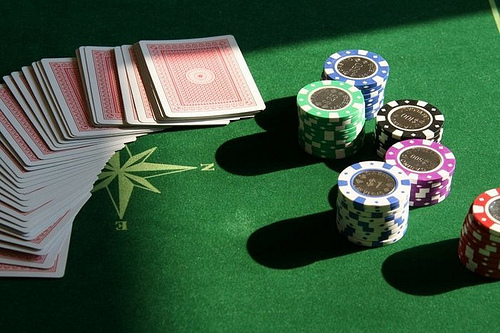Suspense... Or How Films Have Picked Up a Few Lessons From the Casino
FTC Statement: Reviewers are frequently provided by the publisher/production company with a copy of the material being reviewed.The opinions published are solely those of the respective reviewers and may not reflect the opinions of CriticalBlast.com or its management.
As an Amazon Associate, we earn from qualifying purchases. (This is a legal requirement, as apparently some sites advertise for Amazon for free. Yes, that's sarcasm.)

(image left: "Bomb Defusal Puzzle" (CC BY-SA 2.0) by dvanzuijlekom )
It’s the final reel, and it’s all come down to this. Our central protagonist, quirkily handsome hero or feisty-smart heroine, hunched pensively over a suspicious device, pliers in hand as the camera draws in on a digital readout, a counter clicking down to an ominous conclusion.
All the car chases, gunfights, romantic sub-plots and montaged flashbacks lead up to this moment, the plot carefully (or not so carefully) engineered to guide the characters here, for the final telling of their story, a frozen moment of suspense where a single action will dictate consequence.
“So… Do I cut the red wire, or is it the green?”
It’s a familiar scenario, so familiar that it shades into the realm of cliché, a narrative convention which serves to carry the audience along a familiar path in almost any thriller you care to name. Let’s face it, this is the go-to denouement for pretty much every Bond film ever made.
Cut the wrong wire and – kaboom. End of the movie, slim chance for a sequel. The audience files out mumbling in bemused disappointment. Well, that wasn’t supposed to happen, surely..? But this rarely happens, no one wants to end a suspense thriller on a bum note. The pleasure for the audience lies in that single sustained note of peril, strung out interminably with a counter that refuses to adhere to the regular passage of time. Our hero closes his/her eyes, mutters a last prayer or wish, some flippant proto-epitaph. The pliers close on the offending wire, the audience draws a collective breath and everything hangs in the balance. Snip…
Risk works at the movies because risk is at work in real life. Cinema just holds up the mirror. Entrepreneurs and actors hit the big time taking risks, generals get stars and everyone else collects a lottery ticket, all hoping that chance can turn things around.
Online iGaming aficionados 32Red have compiled a roundup of some of the craziest bets ever undertaken, a catalogue of human gambles that defy the imagination. From the punter who wagered his favourite jockey would win all 7 of the races in which he had entered, to the soccer fan who correctly predicted a winning goal from beyond the halfway line to net a 25 grand return, 32Red’s list covers a gamut of real-life gamblers for whom the risks paid off in some style and for considerable reward. Another online casino, Party Poker, have even asked Brian Koppelman of Rounders to make a list of his favourite gambling scenes.
When real life can serve up such accounts as these, the ease with which the risk/reward dilemma translates into compelling narrative becomes all too obvious. Whether it is through a flip of a coin, the slow-motion tumble of dice, or a fan of cards laid out on a plush felted table, the settled traditions of the casino are put to work as a framing mechanism, a ready-made backdrop that comes with its own complement of established conventions and expectations for the viewer to absorb at a subconscious level.

"Poker" (CC BY-SA 2.0) by YLegrand
Hollywood has built an industry on scenes of tightly crafted suspense that milk the inherent tensions of a risky move, where outcomes rest upon a single decision – a gamble against heavy odds, one last throw of the dice in the fickle face of fortune.
Little wonder then that the lustre of the high-roller casino permeates the very fabric of the silver screen and has done since first it found its stride. The pained high-stakes romance of Humphrey Bogart and Ingrid Bergman in 1942’s Casablanca plays out against the card players and dice throwers of the eponymous nightclub where Captain Renault is shocked, shocked to discover that gambling is going on.
But everyone’s at it – gambling with their lives and identities on the storm front of approaching war. The gaming tables where fortunes are won and lost are but background cyphers for the real risks characters are taking as history unfolds around them.
Crime capers, heist movies, straight-laced thrillers set in brutalist near-futures, or indeed exotic alien patrons playing cards in a neon saloon bar full of CGI and animatronic puppetry; the casino set is to be seen everywhere Hollywood treads, as screenwriters grapple with the eternal creative challenge of presenting new stories in familiar audience-friendly ways.
The casino with its seductive whiff of adventure, its frameset of futures and fortunes poised in balance, with every table telling its own story… This cultural iconography has a place in cinema, alongside the barracks scene, the bar fight scene, the inevitable car chase, and all the other core components around which plot can drape the action of the narrative. Set piece scenes like these provide anchor points vital to an audience, a means by which they can engage their attentions. They are a pivot around which drama can freely swing, and signifiers in a landscape against which characters can fall along pre-defined lines, heroes and villains, winners and losers, each of them hostage to the whims of fate and the vagaries of scripting.


